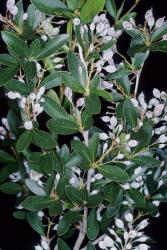- Taxon
- Weed
- Gallery
Glabrous, evergreen or semi-deciduous shrub to c. 7 m high. Shoots terete, grey or yellowish grey; reproductive shoots often pendent. Spines to 2.3 cm long, sometimes single, sometimes 3-partite. Lvs with short petiole to 5 mm long. Lamina mostly 2.5–7.5 × 1–2.5 cm, oblanceolate, elliptic to obovate and often very variable on one plant, entire or spiny serrate (often remotely so), ± shining above and often turning reddish in autumn, reticulate, subcoriaceous, sometimes almost membranous in shadier and moister habitats; base attenuate; apex spiny. Fls foetid, arranged in simple or compound racemes to 6 cm long; bracts 2–3 mm long, lanceolate-acuminate; bracteoles sometimes c. 1/2 way along pedicel, otherwise near base, < bracts. Pedicels 0.6–1.5 mm long. Perianth segments yellow, sometimes the outer red-tinged, 4–7 mm long; outer sepals shorter; inner sepals broadly obovate and petals slightly emarginate, with 2 prominent basal oblong nectaries. Stamens 3–4 mm long. Ovules 4. Berry 7–12 mm long, broadly ellipsoid to subglobose, reddish black, strongly whitish pruinose; juice dark red; fruiting style c. 1 mm long.
[From: Webb et al. (1988) Flora of New Zealand. Volume 4.]
Flowering: Oct.–Nov.




